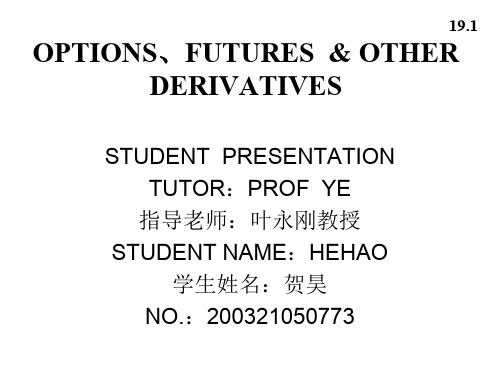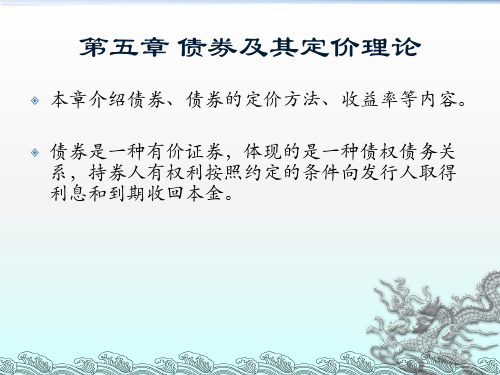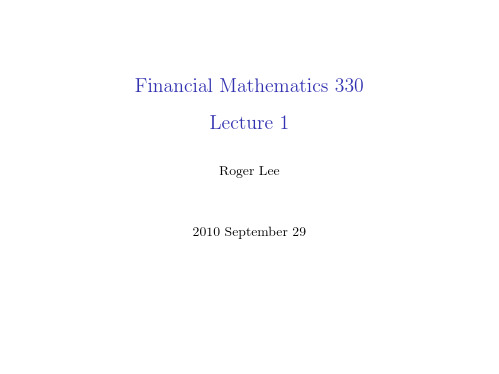金融数学课件(英文版)第5讲
合集下载
金融数学ppt课件

考虑T时刻到期的欧式期权,假定到期时,期 权的内在价值为V(T)=g(P(T));
设V(t,x)表示在t时刻股票价格为x时,期权的价值, 利用Ito公式可得到如下Black-Scholes方程
终V t端(t,条x 件) r V(T x x( ,tx,)x V ) g(1 2 x)2 x 2 V x(t x ,x ) r( V t,x () 5.2)
解上述联立方程可得
0 V S 1 1 ( ( H H ) ) V S 1 1 ( ( T T ) ) ,V 0 1 1 r 1 u r d d V 1 ( H ) u u ( 1 d r ) V 1 ( T ) *
注
0 称为套期保值比。 注意若取
向量自回归模型及其应用 14
1.投资组合理论简介
在投资活动中,人们发现,投资者手中持有多种 不同风险的证券,可以减轻风险带来的损失,对于投 资若干种不同风险与收益的证券形成的证券组称为证 券投资组合。
证券投资组合的原则是,组合期望收益愈大愈好, 组合标准差愈小愈好,但在同一证券市场中,一般情 形是一种证券的平均收益越大,风险也越大,因而最 优投资组合应为一个条件极值问题的解,即对一定的 期望收益率,选择资产组合使其总风险最小。
15
Markowitz 提出的证券组合均值方差问题,是证券 组合理论的基本问题,可描述为有约束的线性规划问
题
mi
n2p
mi w
nwTw
s.t. 1Tw1
E(Xp) E(X)Tw
解上述问题可得最优资产组合w*的表达式,且最 优资产组合的方差为
p 2 a 2 2 b c
诺贝尔经济奖简介(3)
2003年度诺贝尔经济学奖授予 Robert F.Engle和 Clive Granger。
金融数学完整课件全辑

风险管理政策
制定明确的风险管理政策和流程,确保业务 操作的合规性。
危机应对计划
制定应对重大风险的应急预案,确保在危机 发生时能够迅速、有效地应对。
05
投资组合优化
马科维茨投资组合理论
总结词
该理论是现代投资组合理论的基石,它通过 数学模型和优化技术,为投资者提供了构建 最优投资组合的方法。
详细描述
债券是一种常见的固定收益证券,其价格与利率之间存在密切关系。债券定价模型用于确定债券的理 论价格,通常基于现值计算方法。不同类型的债券(如国债、企业债等)具有不同的风险和收益特征 ,因此需要采用不同的定价模型。
复杂衍生品定价
总结词
概述了复杂衍生品定价的难点和方法, 包括信用衍生品、利率衍生品和商品衍 生品等。
数据清洗
对数据进行预处理,去除异常值、缺 失值和重复值,提高数据质量。
数据存储
采用分布式存储系统,高效地存储和 管理大规模金融数据。
数据可视化
通过图表、图像等形式直观地展示数 据分析结果,帮助用户更好地理解数 据。
机器学习在金融中的应用
风险评估
信贷审批
利用机器学习算法对历史金融数据进行分 析,预测未来市场走势和风险状况。
微积分
微积分是研究函数、极限、导数和积 分的数学分支。在金融领域,微积分 用于计算金融衍生品的价格和风险度 量。
线性代数
线性代数是研究线性方程组、矩阵和 向量空间的数学分支。在金融领域, 线性代数用于数据处理、模型建立和 优化问题求解等方面。
03
金融衍生品定价
期权定价模型
总结词
详细描述了期权定价模型的基本原理、应用场景和优缺点。
通过机器学习模型对借款人的信用状况进 行评估,提高信贷审批的效率和准确性。
北大金融学课件(英文版)第5章(4课时)

CHAPTER 5 What Determines Exchange Rates?
© 2008 , All Copy Rights Reserved.
5-2
The Variability of Exchange Rate
Three types of variability after early 1970s. • Long-term trends • Medium-term trends (which can be counter to the long-term trends) • Short-term trends
A country with a relatively low inflation rate will have an appreciating currency (an increasing nominal-exchange-rate value of its currency).
© 2008 , All Copy Rights Reserved.
© 2008 , All Copy Rights Reserved.
5-3
Figure 5.1, Panel A
© 2008 , All Copy Rights Reserved.
5-4
Figure 5.1, Panel B
© 2008 , All Copy Rights Reserved.
5-5
© 2008 , All Copy Rights Reserved.
5-12
In the Long run: Purchasing Power Parity
· Changes over time (relative PPP):
From time 0 to time t:
© 2008 , All Copy Rights Reserved.
5-2
The Variability of Exchange Rate
Three types of variability after early 1970s. • Long-term trends • Medium-term trends (which can be counter to the long-term trends) • Short-term trends
A country with a relatively low inflation rate will have an appreciating currency (an increasing nominal-exchange-rate value of its currency).
© 2008 , All Copy Rights Reserved.
© 2008 , All Copy Rights Reserved.
5-3
Figure 5.1, Panel A
© 2008 , All Copy Rights Reserved.
5-4
Figure 5.1, Panel B
© 2008 , All Copy Rights Reserved.
5-5
© 2008 , All Copy Rights Reserved.
5-12
In the Long run: Purchasing Power Parity
· Changes over time (relative PPP):
From time 0 to time t:
金融工程讲义(ppt 30页)(英文版)

19.18
Forward Prices
In a world that is FRN wrt P(0,T), the expected value of a security at time T is its forward price
19.19
Interest Rates
In a world that is FRN wrt P(0,T2) the expected value of an interest rate lasting between times T1 and T2 is the forward interest rate
If Eg denotes a world that is FRN wrt g
f0 g0
E
g
fT gT
19.14
Aleternative Choices for the Numeraire Security g
• Money Market Account • Zero-coupon bond price • Annuity factor
d m dt s dz Imagine two derivatives dependent on
with prices ?1 and ?2. Suppose
d ?1 ƒ1
1
dt
1
dz
d ƒ2 ƒ2
2
dt 2
dz
19.4
Forming a Riskless Portfolio
We can set up a riskless portfolio , consisting of + 2 ƒ2 of the 1st derivative and 1ƒ1 of the 2nd derivative
金融数学课件资料PPT课件

期次(半年)
票息
0
1
40.00
2
40.00
3
40.00
4
40.00
合计
160.00
利息收入 折价累计额
48.23 48.64 49.07 49.52 195.46
8.23 8.64 9.07 9.52 35.46
账面值
964.54 972.77 981.41 990.48 1000.00
例题5-3
例:债券的面值为1000元,年息票率为6% ,期限为3年,到期按面值偿还。市场利率 为8%,试计算债券在购买6个月后的价格 和帐面值。
解:已知: C = F= 1000 r = g = 6% n=3 i= 8% 所以债券在购买日的价格为
在购买6个月后的价格为
在购买6个月后的帐面值等于价格扣除 应计息票收入: 按理论方法计算
P Nr(1 t)a Cvn n
Nr(1 t)a K n
该公式称为计算债券价格的基本公式,债券价格 的计算还有另外两种变型公式:
(1)溢价/折价公式: P C [Nr(1 t) Ci]a n
(2)Makeham公式: P K g(1 t) (C K )
例:
面值1000元的五年期债券,票息率为每年 计息两次的年名义利率10%,可以面值赎 回,现以每年计息两次的年名义利率12% 的收益率购买,求分期偿债表中的总利息 收入。
SUCCESS
THANK YOU
•
5.1.3票息支付周期内债券的估价
债券的平价:债券购买日的实际交付款项 债券的市价:扣除应计票息后的买价 计算方法: 理论法 实务法 混合法
债券的面值N=1000 债券的收益率i=0.05
金融市场和净现值讲义(英文版)(ppt 23页)

• We can illustrate this by graphing consumption today versus consumption in the future.
• This graph will show intertemporal consumption opportunities.
Ms. Patience
to be.
Ms. Impatience
$20,000
$40,000
$60,000
$80,000
$100,000
$120,000
Consumption today
Copyright © 2002 by The McGraw-Hill Companies, Inc. All rights reserved.
$80,000
$100,000
$120,000
Consumption today
Copyright © 2002 by The McGraw-Hill Companies, Inc. All rights reserved.
3-8
Intertemporal Consumption Opportunity Set
McGraw-Hill/Irwin
Copyright © 2002 by The McGraw-Hill Companies, Inc. All rights reserved.
3-7
Intertemporal Consumption Opportunity Set
Consumption at t+1
3-4
The Financial Market Economy: Example
• Financial intermediation can take three forms:
• This graph will show intertemporal consumption opportunities.
Ms. Patience
to be.
Ms. Impatience
$20,000
$40,000
$60,000
$80,000
$100,000
$120,000
Consumption today
Copyright © 2002 by The McGraw-Hill Companies, Inc. All rights reserved.
$80,000
$100,000
$120,000
Consumption today
Copyright © 2002 by The McGraw-Hill Companies, Inc. All rights reserved.
3-8
Intertemporal Consumption Opportunity Set
McGraw-Hill/Irwin
Copyright © 2002 by The McGraw-Hill Companies, Inc. All rights reserved.
3-7
Intertemporal Consumption Opportunity Set
Consumption at t+1
3-4
The Financial Market Economy: Example
• Financial intermediation can take three forms:
金融数学 第 (5)节51页PPT

39、勿问成功的秘诀为何,且尽全力做你应该做的事吧。——美华纳
40、学而不思则罔,思而不学则殆。——孔子
•
30、风俗可以造就法律,也可以废除 法律。 ——塞·约翰逊
金融数学 第 (5)节
谢谢!
36、自己的鞋子,自己知道紧在哪里。——西班牙
37、我们唯一不会改正的缺点是软弱。——拉罗什福科
xiexie! 38、我这个人走得很慢,但是我从不后退。——亚伯拉罕·林肯
•
26、我们像鹰一样,生来就是自由的 ,但是 为了生 存,我 们不得 不为自 己编织 一个笼 子,然 后把自 己关在 里面。 ——博 莱索
•
27、法律如果不讲道理,即使延续时 间再长 ,也还 是没有 制约力 的。— —爱·科 克
Hale Waihona Puke •28、好法律是由坏风俗创造出来的。 ——马 克罗维 乌斯
•
29、在一切能够接受法律支配的人类 的状态 中,哪 里没有 法律, 那里就 没有自 由。— —洛克
金融数学课件(英文版)第1讲

Introduction General properties of arbitrage-free prices One-period binomial model
L1.11
Arbitrage
Prices which admit arbitrage are, in some sense, incorrect. Existence of arbitrage is a severe form of the inconsistency and mispricing that we want to avoid. Assume no arbitrage, unless otherwise indicated. Thus, when we try to price some security, we are looking for an arbitrage-free price. Some authors define arbitrage without “type 2”. The distinction between our definition and their definition is essentially harmless, because: If there exists an asset whose price is always nonnegative and not always zero, then type 1 arb exists whenever type 2 arb exists. Bj¨rk’s term for arbitrage is “arbitrage possibility.” o
Introduction General properties of arbitrage-free prices One-period binomial model
L1.11
Arbitrage
Prices which admit arbitrage are, in some sense, incorrect. Existence of arbitrage is a severe form of the inconsistency and mispricing that we want to avoid. Assume no arbitrage, unless otherwise indicated. Thus, when we try to price some security, we are looking for an arbitrage-free price. Some authors define arbitrage without “type 2”. The distinction between our definition and their definition is essentially harmless, because: If there exists an asset whose price is always nonnegative and not always zero, then type 1 arb exists whenever type 2 arb exists. Bj¨rk’s term for arbitrage is “arbitrage possibility.” o
Introduction General properties of arbitrage-free prices One-period binomial model
- 1、下载文档前请自行甄别文档内容的完整性,平台不提供额外的编辑、内容补充、找答案等附加服务。
- 2、"仅部分预览"的文档,不可在线预览部分如存在完整性等问题,可反馈申请退款(可完整预览的文档不适用该条件!)。
- 3、如文档侵犯您的权益,请联系客服反馈,我们会尽快为您处理(人工客服工作时间:9:00-18:30)。
1 2 Xt Xt XN , ,··· , t Bt Bt Bt
is a martingale under P (meaning, each component is a martingale). For any self-financing trading strategy Θt with value Vt , we’ll show that V /B is a martingale, where Vt := Θt · Xt . Once we show this, we are done, because the familiar argument applies: If V0 = 0, then V0 /B0 = 0, hence E(VT /BT ) = 0. If also VT ≥ 0, then VT /BT ≥ 0, so VT /BT = 0, hence VT = 0 Conclusion: Θ is not an arbitrage.
Fundamental theorem in continuous time Black-Scholes
L5.6
Fundamental theorem: Proof
No arb ⇒ ∃ equivalent martingale measure P: Intuition of proof: Same as L2.21-L2.24. Let’s simplify the problem by assuming only J possible time-T outcomes Ω = {ω1 , . . . , ωJ }. For each j = 1, . . . , J, define the jth Arrow-Debreu asset to be a contract paying: 1 unit of BT if and when ωj occurs, else 0. Let pj be the time-0 value of the jth Arrow-Debreu asset, where value is expressed in units of the asset B. So pj is how many units of B it costs today, to buy 1 unit of B in the event that ωj occurs. (But what’s “the value” of an A-D asset that does not trade? If market is complete, it’s the value of a replicating portfolio. If market is incomplete, then proof becomes more difficult.)
L5.1
Financial Mathematics 330 Lecture 5
Roger Lee
2010 November 3
Fundamental theorem in continuous time
Black-Scholes
L5.2
Fundamental theorem in continuous time
Fundamental theorem in continuous time
then dYt = ρt dMt = ρt σt dWt , which is driftless.
Black-Schheorem: Proof
∃ equivalent martingale measure P ⇒ No arb: We are given that the vector of discounted asset prices 1 Xt := Bt
Fundamental theorem in continuous time
change measure, then we can find out what happens to S.
Black-Scholes
L5.10
Girsanov’s theorem
In this class we will need only one fact from the Girsanov theory of measure change. We will need only what Bj¨rk (2nd/3rd) calls the o “converse of Girsanov”. Theorem: If W is a Brownian motion under P,
j
pj = 1.
To check the MG property, let X be the price (in dollars) of any asset. Then X0 = B0
J
j=1
XT (ωj ) XT · pj = E BT (ωj ) BT
The first step simply says that the time-0 value of X equals the value of the portfolio of Arrow-Debreu assets that replicates XT (where all values are expressed in units of B). That portfolio holds XT (ωj )/BT (ωj ) units of the jth A-D asset, and the portfolio’s total value is the sum of quantity times price. The concluding step is by definition of expectation wrt P.
Black-Scholes
Fundamental theorem in continuous time
Black-Scholes
L5.3
More about martingales in Brownian settings
[Under integrability conditions. . . ]
N
= Θt · d(At Xt ) =
n=1
n n θt d(At Xt )
n Since each At Xt is a martingale, AV = V /B is a martingale also.
Idea: Martingales are wealth processes arising from zero-expectation games. Varying your bet size across games and across time still produces, collectively, a zero-expectation game. Can’t risklessly make something from nothing by playing zero-expectation games.
Fundamental theorem in continuous time Black-Scholes
L5.7
Fundamental theorem: Proof
Define P({ωj }) := pj . Can check this really is an equivalent measure: pj > 0 and
Fundamental theorem in continuous time Black-Scholes
L5.8
Fundamental theorem: Comments
Idea: The P probability of an event is simply the price (in units of B) of a asset that pays 1 unit of B iff that event occurs. Note: In this entire proof, we never assumed that B is the bank account, and never assumed that it is riskless. It is enough to assume that B is some asset with positive price process. Later, in some applications, we will prefer to normalize using some such asset (some numeraire) that is not the bank account. By default, if we say risk-neutral or martingale measure without specifying the numeraire, it is understood to be the bank account.
Fundamental theorem in continuous time Black-Scholes
L5.5
Fundamental theorem: Proof
To see that V /B is a martingale, let At := 1/Bt . Then d(At Vt ) = Vt dAt + At dVt + dAt dVt = Θt · Xt dAt + At (Θ · dXt ) + dAt Θt · dXt = Θt · (Xt dAt + At dXt + dAt dXt )
W M is a martingale wrt {Ft }t≥0 if and only if there exists an
adapted process σ such that dMt = σt dWt This is a form of the martingale representation theorem. We knew that every Itˆ integral is a martingale. This says that o conversely every martingale is an Itˆ integral plus a constant. o If M is a martingale, then stochastic integrals with respect to M are martingales. That’s because dMt = σt dWt for some σt , so if dYt = ρt dMt
is a martingale under P (meaning, each component is a martingale). For any self-financing trading strategy Θt with value Vt , we’ll show that V /B is a martingale, where Vt := Θt · Xt . Once we show this, we are done, because the familiar argument applies: If V0 = 0, then V0 /B0 = 0, hence E(VT /BT ) = 0. If also VT ≥ 0, then VT /BT ≥ 0, so VT /BT = 0, hence VT = 0 Conclusion: Θ is not an arbitrage.
Fundamental theorem in continuous time Black-Scholes
L5.6
Fundamental theorem: Proof
No arb ⇒ ∃ equivalent martingale measure P: Intuition of proof: Same as L2.21-L2.24. Let’s simplify the problem by assuming only J possible time-T outcomes Ω = {ω1 , . . . , ωJ }. For each j = 1, . . . , J, define the jth Arrow-Debreu asset to be a contract paying: 1 unit of BT if and when ωj occurs, else 0. Let pj be the time-0 value of the jth Arrow-Debreu asset, where value is expressed in units of the asset B. So pj is how many units of B it costs today, to buy 1 unit of B in the event that ωj occurs. (But what’s “the value” of an A-D asset that does not trade? If market is complete, it’s the value of a replicating portfolio. If market is incomplete, then proof becomes more difficult.)
L5.1
Financial Mathematics 330 Lecture 5
Roger Lee
2010 November 3
Fundamental theorem in continuous time
Black-Scholes
L5.2
Fundamental theorem in continuous time
Fundamental theorem in continuous time
then dYt = ρt dMt = ρt σt dWt , which is driftless.
Black-Schheorem: Proof
∃ equivalent martingale measure P ⇒ No arb: We are given that the vector of discounted asset prices 1 Xt := Bt
Fundamental theorem in continuous time
change measure, then we can find out what happens to S.
Black-Scholes
L5.10
Girsanov’s theorem
In this class we will need only one fact from the Girsanov theory of measure change. We will need only what Bj¨rk (2nd/3rd) calls the o “converse of Girsanov”. Theorem: If W is a Brownian motion under P,
j
pj = 1.
To check the MG property, let X be the price (in dollars) of any asset. Then X0 = B0
J
j=1
XT (ωj ) XT · pj = E BT (ωj ) BT
The first step simply says that the time-0 value of X equals the value of the portfolio of Arrow-Debreu assets that replicates XT (where all values are expressed in units of B). That portfolio holds XT (ωj )/BT (ωj ) units of the jth A-D asset, and the portfolio’s total value is the sum of quantity times price. The concluding step is by definition of expectation wrt P.
Black-Scholes
Fundamental theorem in continuous time
Black-Scholes
L5.3
More about martingales in Brownian settings
[Under integrability conditions. . . ]
N
= Θt · d(At Xt ) =
n=1
n n θt d(At Xt )
n Since each At Xt is a martingale, AV = V /B is a martingale also.
Idea: Martingales are wealth processes arising from zero-expectation games. Varying your bet size across games and across time still produces, collectively, a zero-expectation game. Can’t risklessly make something from nothing by playing zero-expectation games.
Fundamental theorem in continuous time Black-Scholes
L5.7
Fundamental theorem: Proof
Define P({ωj }) := pj . Can check this really is an equivalent measure: pj > 0 and
Fundamental theorem in continuous time Black-Scholes
L5.8
Fundamental theorem: Comments
Idea: The P probability of an event is simply the price (in units of B) of a asset that pays 1 unit of B iff that event occurs. Note: In this entire proof, we never assumed that B is the bank account, and never assumed that it is riskless. It is enough to assume that B is some asset with positive price process. Later, in some applications, we will prefer to normalize using some such asset (some numeraire) that is not the bank account. By default, if we say risk-neutral or martingale measure without specifying the numeraire, it is understood to be the bank account.
Fundamental theorem in continuous time Black-Scholes
L5.5
Fundamental theorem: Proof
To see that V /B is a martingale, let At := 1/Bt . Then d(At Vt ) = Vt dAt + At dVt + dAt dVt = Θt · Xt dAt + At (Θ · dXt ) + dAt Θt · dXt = Θt · (Xt dAt + At dXt + dAt dXt )
W M is a martingale wrt {Ft }t≥0 if and only if there exists an
adapted process σ such that dMt = σt dWt This is a form of the martingale representation theorem. We knew that every Itˆ integral is a martingale. This says that o conversely every martingale is an Itˆ integral plus a constant. o If M is a martingale, then stochastic integrals with respect to M are martingales. That’s because dMt = σt dWt for some σt , so if dYt = ρt dMt
